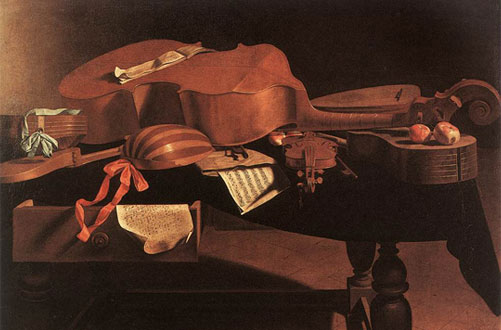The term Baroque is used for the European epoch from about 1600 till 1750. The individual no longer perceives himself only as an image of God and the measure and beauty ideal as in the Renaissance, but as a feeling being with passions and imagination as well.
The baroque state is a feudal society, upheld by force. The religious splitting, the struggles for power of the princes and the Thirty Years' War (1618-1648) destroy the old orders, in the towns the educated and propertied bourgeoisie gains power, while the rural population pauperizes increasingly.
The courtly Baroque is sumptuous and radiant, loves opulence and extremes and extends the limitations of reality by a fantastic illusionism. The worldview is harmonious and ordered rationally. A profound stylization and regimentation of all aspects of life is carried out, as the passions of man are perceived to be controllable only by rational, rigid order.
The new human consciousness also determines the relation to nature and the environment, not tradition and faith but empiricism and criticism must lead the individual and society. Scientific and artistic academies are founded to improve craftsmanship and artistic skills, the ethics and morality that are taught are determined by human experience and thinking. It is proven that the earth is not the centre of the universe. The antique idea of the harmony of spheres determines substantially the views on music and the theoretical studies.
The artist does not imitate nature anymore, he works as creative genius on his own creations, in inner harmony with his sentiment and reason. Every man-made form signifies a refusal of nature, the whole world becomes a theater with actors, a master of ceremony and a musical background, all playing their parts. Did the metaphysical orientation in the Middle Ages shape all areas of human existence, the man of the Baroque lives in the here and now, visible in the castles and churches, audible in the individualism of the concertante style. The upper classes support the music culture, which is cultivated not only at court and in church, but also in the urban setting of towns and schools.
The human being does not yet perceive himself as an individual with personal freedom, nevertheless human affects and sentiments are expressed, still this does not imply the personal, individualistic expression of feelings but a stylized representation, regulated by the doctrine of the affects (the musical representation of the passions and the states of mental excitement).
In the beginnings around 1600 the new Baroque style exists simultaneously with the old polyphony of the Renaissance. To later musicians the music of the Baroque appears for a long time to be too grandiloquent, ornate, harmoniously abstruse, full of dissonances, unnatural and melodically difficult.
 Instrumentos barrocos incluindo sanfona, cravo, viola da gamba, violão, violino e guitarra barroca.
Instrumentos barrocos incluindo sanfona, cravo, viola da gamba, violão, violino e guitarra barroca.
From the Renaissance the Baroque has taken on the tone-symbolism and has developed it further, the musical appearance represents extra-musical content. The theory of composition brings some structural innovations: major-minor harmony, figured bass, the concertante style, the monody and the modern time system. Starting from Italy the new opera spreads quickly, already in 1637 the first public opera house is established in Venice. Besides the opera the Passion and the Mass are established as larger dramatic forms. The sonata is developed as well as the suite, the cantata, the oratorio and the concerto grosso, later the solo concert. Chamber music with the trio sonata as main genre develops continually from 1600 onwards, as well as the origin respectively the structure of the orchestra and the first independent instrumental compositions. In the Baroque the organ reaches not only the construction ideal but also its musical climax. The lute, the most popular domestic instrument of the Renaissance, hands its place over to the harpsichord, the violin becomes an instrument of importance, often even leading the orchestra.